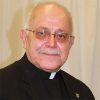Maryknoll Father Joseph Veneroso explains his hometown connection to Kateri Tekakwitha, first native American woman to be canonized a saint.
When Pope Benedict XVI announced in December 2011 that Kateri Tekakwitha, “The Lily of the Mohawks,” would be canonized in Rome the following year, I knew I had to attend. Born in Amsterdam, N.Y., on the banks of the Mohawk River just seven miles from her birthplace, I was raised on tales of Kateri as well as those of the Jesuit missionaries who proclaimed the Gospel among Native Americans in that area and became the first North American martyrs.
As high school students, every Good Friday several classmates and I walked the seven miles to the Auriesville Shrine to Kateri and the martyrs. We were drawn by the sylvan serenity surrounding the shrine and the tales of the Jesuit martyrs. But it was Kateri who most captivated me.
Kateri was born in 1656 in a Mohawk village in present-day Auriesville. Smallpox, which decimated the Native American population, claimed her parents and brother, and scarred her face severely and impaired her vision. This earned her the nickname “Tek-ak-wit-ha,” meaning “she who bumps into things.” Kateri learned about Jesus from her Huron aunt, also a convert to the faith. Kateri was forced to take refuge in the nearby Mohawk village of Caughnawaga, present-day Fonda, after French soldiers and Iroquois burned her village when she was 10. She was baptized there at age 20. Ridiculed and threatened by her neighbors for her faith, she fled on foot to a Jesuit settlement of Catholic Indians near Montreal, Canada.
As typical teenagers, my classmates and I shared the sense of alienation from familial and cultural customs Kateri must have felt as her new faith isolated her from her Mohawk kin. While our feet ached after just seven miles, how much more did Kateri undergo to escape to Canada?
From the hillside slope overlooking the Mohawk, it wasn’t hard for us to envision the Native Americans coming around the bend in their canoes. Just above a huge cross made of pine trees, a rosary made of rocks and stones was laid out on the hillside. Legend has it that Kateri, having been deprived of one of her favorite devotions by fellow Mohawks opposed to Christianity, fashioned a similar rosary and prayed it on her knees. In her honor, we did the same.
Jesuit missionaries have portrayed her as somewhat of a mystic, who spent hours alone in the forest among her beloved trees and animals, which appealed to the budding environmentalist in me. Yet, Kateri also attended to the sick and elderly of the settlement, contracting the illness that took her life on April 17, 1680, at age 24. Witnesses record that at the moment of her death, her ravaged face became clear and smooth. Reports of miracles attributed to her intercession began almost immediately, but it was the 2006 miraculous healing of a young boy, Jake Finkbonner, who suffered from a flesh-eating bacteria, that convinced Vatican officials of her sanctity.
Standing for five hours under the bright Italian sun on the morning of Oct. 21, 2012, to witness Kateri’s canonization brought a smile to my eyes, as my sore feet made a physical connection to Kateri’s trek and my pilgrimages past.
“This is such a wonderful day for all of us,” observed Patricia Ferguson, a Canadian Cree, also standing at the Vatican. “We’ve been waiting a long time.” That “we” referred to Native American Catholics, but it included me nonetheless. In this Year of Faith, I could observe the July 14th feast day of St. Kateri, the first Native American woman to be canonized.
I go back “home” as often as I can and I know well the Auriesville Shrine and St. Kateri Shrine in Fonda. My faith too was nurtured in the Mohawk River valley, and while I can’t pretend to share St. Kateri’s suffering, when I walk those woods, I still feel a sibling kinship with the Lily of the Mohawks.
Featured image: Statue of St. Kateri on the Maryknoll Sisters’ property is a fitting tribute to the patroness of ecology. (J. McLaughlin/U.S)

